
Akiyama Nobutomo was a samurai during the Sengoku period in Japan. He is known as one of the "Twenty-Four Generals of Takeda Shingen". Nobutomo also served under Shingen's son, Takeda Katsuyori.

Matsumoto Castle, originally known as Fukashi Castle, is one of Japan's premier historic castles, along with Himeji and Kumamoto. It was the seat of Matsumoto Domain under the Edo Period Tokugawa shogunate. It is located in the city of Matsumoto, in Nagano Prefecture.

Iwamura Castle was located in the southeastern area of Mino Province in Japan. Its ruins can be found in the modern-day municipal subdivision of Iwamura, in Ena, Gifu Prefecture. Along with Takatori Castle in Nara and Bitchu-Matsuyama Castle in Okayama, it is regarded as one of the three best mountain castles, and at an elevation of 721 meters above sea level, it is one of the highest in Japan.

Gifu Castle is a Japanese castle located in the city of Gifu, Gifu Prefecture, Japan. Along with Mount Kinka and the Nagara River, it is one of the main symbols of the city. The castle is also known as Inabayama Castle. It was designated a National Historic Site in 2011.

Ueda Castle is a Japanese castle located in Ueda, northern Nagano Prefecture, Japan. At the end of the Edo period, Ueda Castle was home to a cadet branch of the Matsudaira clan, daimyō of Ueda Domain, but the castle is better known for its association with the Sengoku period Sanada clan. It was also called Amagafuji-jō or Matsuo-jō. The castle was designated a National Historic Site of Japan in 1934.

Inuyama Castle is a yamajiro-style Japanese castle located in the city of Inuyama, Aichi Prefecture, Japan. The castle overlooks the Kiso River, which serves as the border between Aichi and Gifu Prefectures. The tenshu of Inuyama Castle, one of only 12 pre-modern tenshu remaining in existence, has been determined to be the oldest remaining tenshu, dating from the late 1580s. The castle has been a National Historic Site since 2018.
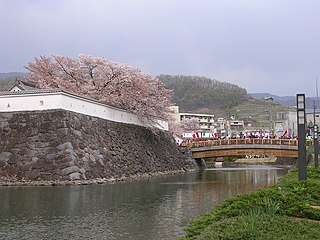
Kōfu Castle was a Japanese castle located in the city of Kōfu, Yamanashi Prefecture, in the Chubu region of Japan. The site has been protected as a National Historic Site since 2019. The castle is also known as Maizuru Castle, and the present-day surroundings are called Maizuru Castle Park.
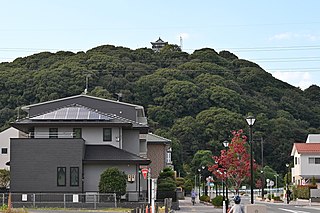
Mount Komaki is an 86 m-high (282 ft) mountain located in the city of Komaki, Aichi Prefecture, Japan. At one point, the mountain was topped with the original Komakiyama Castle, built by Oda Nobunaga. Its base stretches for nearly 600 m (1,969 ft) from east to west, and 400 m (1,312 ft) from north to south, covering an area of approximately 21 ha. The mountain is now a historical park, containing various castle ruins, including water wells and stone walls, in addition to artifacts dating further back. Though known for the sakura trees, the northern part of the mountain is home to many Machilus thunbergii trees. This is the only spot in the surrounding area where these trees occur naturally. The reproduction of Komakiyama Castle was built in 1967 and houses the Komaki City Historical Museum.

Gujō Hachiman Castle is a yamashiro, or "mountain castle", located on Hachiman Mountain in the city of Gujō, Gifu Prefecture, Japan. Its ruins were designated a Gifu Prefecture Historic Site in 1955.

Ōgaki Castle is a flatlands-style Japanese castle located in the city of Ōgaki, Gifu Prefecture, Japan. During the Sengoku period, Ōgaki Castle was home to several of Toyotomi Hideyoshi's most trusted generals and relatives; during the Edo period, it was home to the Toda clan, daimyō of Ōgaki Domain, who dominated parts of the province of Mino under the Tokugawa shogunate. Other names for the castle include Bi Castle and Kyoroku Castle.

Toyama Castle is a flatland-style Japanese castle located in the city of Toyama, Toyama Prefecture, in the Hokuriku region of Japan. It is also called Azumi Castle. Built in 1543, the castle and its surrounding land is maintained by the government of Japan as a public park.

Numazu Castle was a Japanese castle located in the city of Numazu, Shizuoka Prefecture, Japan. It was a hirayama-jō, a castle built on a plains rather than a hill or mountain. During the Edo period, Numazu castle was home to the Mizuno clan, daimyō of Numazu Domain under the Tokugawa shogunate.

Toba Castle was a Japanese castle located in the city of Toba, Mie Prefecture, Japan. Throughout the Edo period, Toba Castle was the administrative center for Toba Domain, a feudal domain of Shima Province under the Tokugawa shogunate. Toba Castle was also known as the Floating Castle of Toba or the Two-color Castle. The castle site received protection as a Mie Prefectural Historic Site in 1965.
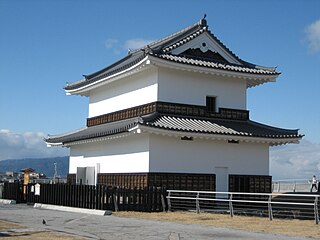
Kuwana Castle is a Japanese castle located in Kuwana, northern Mie Prefecture, Japan. At the end of the Edo period, Kuwana Castle was home to a branch the Matsudaira clan, daimyō of Kuwana Domain. The castle was also known as "Ōgi-jō" (扇城) or "Asahi-jō" (旭城).

Maebashi Castle is a castle located in Maebashi, central Gunma Prefecture, Japan. At the end of the Edo period, Maebashi Castle was home to a branch of the Matsudaira clan, daimyō of Maebashi domain, although the castle was ruled by a large number of different clans over its history. The castle was also known as "Mayabashi-jō" (厩橋城), after the former name of Maebashi.
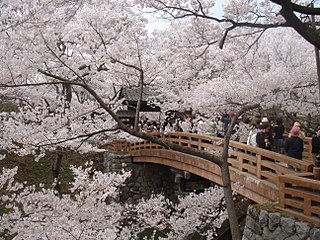
Takatō Castle is a Japanese castle located in the city of Ina, southern Nagano Prefecture, Japan. At the end of the Edo period, Takatō Castle was home to a cadet branch of the Naitō clan, daimyō of Takatō Domain. The castle was also known as Kabuto Castle. Built sometime in the 16th century, it is now largely ruins.
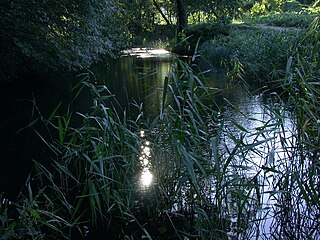
Shinpu Castle was a Sengoku period hirayama-style Japanese castle located in what is now part of the city of Nirasaki, Yamanashi prefecture. It was the primary fortress of the warlord Takeda Katsuyori. The ruins have been protected as a National Historic Site since 1973.

Naegi Domain was a feudal domain of Edo period Japan It was located in Mino Province, in central Honshū. The domain was centered at Naegi Castle, located in what is now the city of Nakatsugawa in Gifu Prefecture. It is the smallest domain within the Tokugawa shogunate which was styled as a “castle holding domain”.

Mino Kaneyama Castle was a Sengoku period Japanese castle located in Kani, Gifu Prefecture, Japan. In 1981, the ruins were designated as a National Historic Site. It was also known as Karasumine Castle.
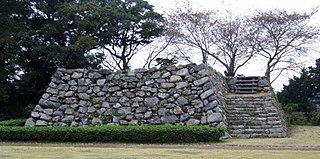
Futamata Castle was a Japanese castle located in Toyoda county of Tōtōmi Province, in what is now part of Tenryū-ku in the city of Hamamatsu, Shizuoka Prefecture, Japan. It was built in the Sengoku period and is noted as the site of the death of Tokugawa Ieyasu's son Matsudaira Nobuyasu in 1579. In 2018, the ruins were recognized as a National Historic Site together with adjacent Tobayama Castle.




























